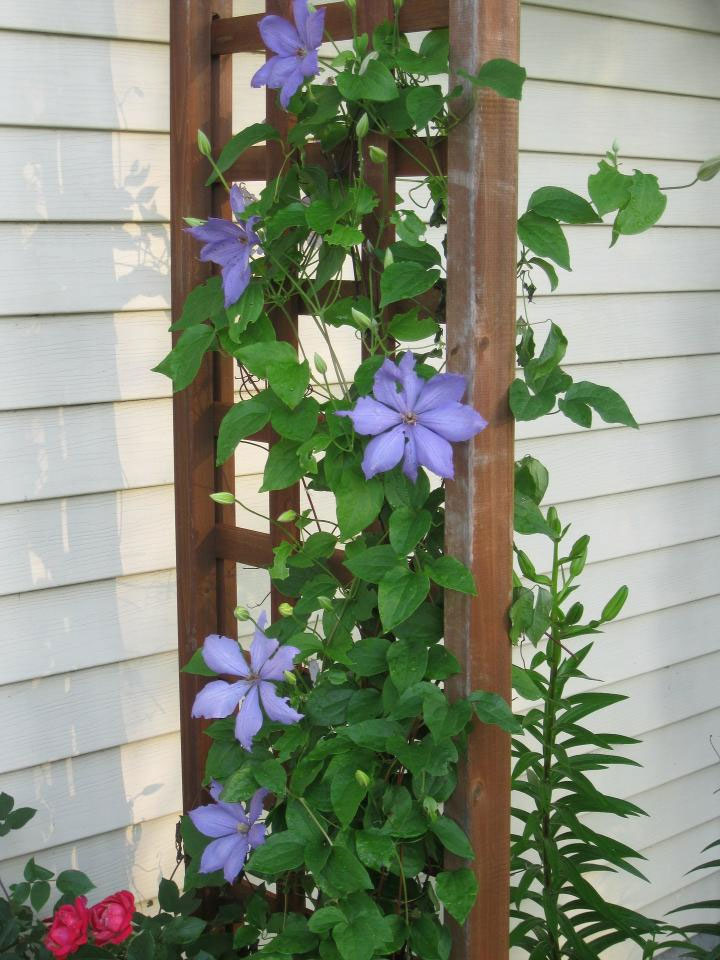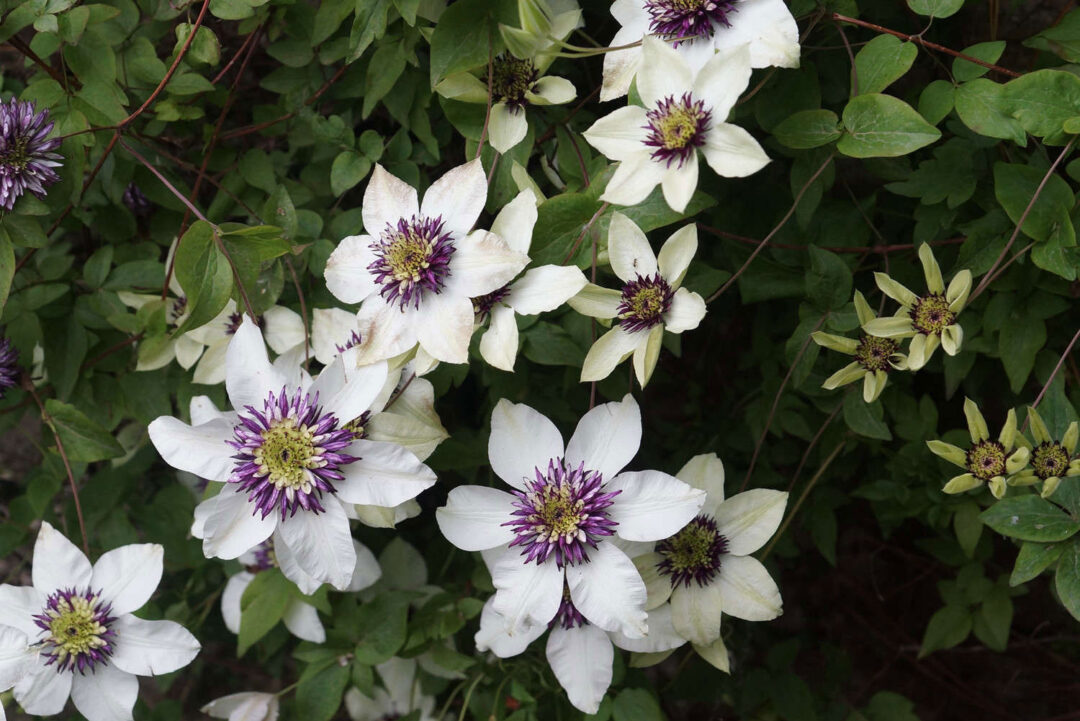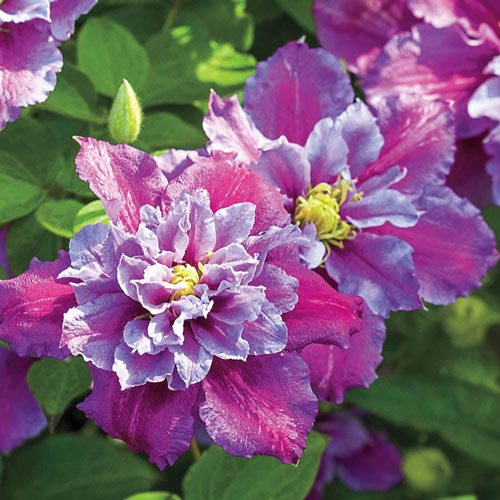When to prune Clematis? And when do you need to prune Clematis?
Even though a lot of gardening, I’ve always been confused on when and how much to prune Clematis. Everyone loves a flush of gorgeous flowers climbing on fences, poles or even mailboxes. But when the flowers fail to come out the next year, it may be because they were not pruned properly.
I have several clematis I’ve planted over the years, and never know when and if I should prune, so I leave them alone. 
But some of them are getting out of control and look like a rat’s nest, so I finally researched what to do with Clematis.
There are three basic categories of growth. And there are 300 species of Clematis and hundreds of hybrids.
An easy way to understand pruning practices with Clematis is the “Stoplight Pruning” method.
GREEN CATEGORY – GO AHEAD AND PRUNE
Green Category Clematis are vigorous bloomers. Each year, Green Category plants bloom primarily on new vines, often quite prolifically. Vines older than the current season may not be strong or viable. Each spring, prune the plants down to just above the lowest node showing growth, which may be just a few inches above the soil. Large, established plants can be pruned flat to the soil, which helps them initiate new stems. In most U.S. climates, new growth from the mid-season will rebloom. Most sprawling, shrubby Clematis are in the Green category, as are later-blooming varieties.
YELLOW CATEGORY – SLOW PRUNING
Some Yellow Category Clematis cultivars can flower on new growth, but they tend to produce larger flowers on older vines from prior years. Prune cautiously. In spring, prune to remove ends that are damaged or showing no signs of new growth. A good rule of thumb is to cut the stem right above the highest set of fat buds that are breaking growth. Right after the first flowering period of the season, prune your Clematis to remove damaged vines. Yellow Category Clematis can also be pruned to maintain plant size. Many of the largest-flowering Clematis are in the Yellow Category.
RED CATEGORY – NO PRUNING
Red Category Clematis only flower well on the prior year’s growth. Do not prune in Spring. Trim right after the first flush of flowers, but only to remove growth above a broken or damaged stem. Red Category Clematis can be pruned to maintain a tidy size, but do so carefully and with as few cuts as possible. Red Category Clematis are usually the earliest-blooming Clematis in your garden.
Piilu Clematis
Group 1 (spring bloomers) RED CATEGORY
This group doesn’t need pruning, but you can remove old or damaged stems after they have finished flowering, if needs be.
C. alpina
‘Burford White’
‘Columbine’
‘Franci Rivis’
‘Frankie’
‘Jacqueline du Pré’
‘Pamela Jackman’
‘Rosy Pagoda’
‘Ruby’
‘White Columbine’
‘Willy’
C. alpina subsp. sibirica
‘White Moth’
C. armandii
‘Apple Blossom’
‘Snowdrift’
C. chiisanensis
C. chrysocoma and cvs.
‘Continuity’
C. cirrhosa
C. cirrhosa var. balearica
C. columbiana
C. finetiana
C. foetida
C. forsteri
C. gentianoides
C. japonica
C. macropetala and cvs.
‘Blue Bird’
‘Maidwell Hall’
‘Markham’s Pink’
‘Snowbird’
C. marata
C. marmoraria
C. meyeniana
C. montana and cvs. f. grandiflora
‘Alexander’
‘Elizabeth’
‘Peveril’
‘Picton’s Variety’
‘Tetrarose’
C. napaulensis
C. petriei
C. phlebantha
C. quinquefoliolata
C. spooneri
C. uncinata
C. × vedrariensis and cvs.
‘Highdown’
Group 2 (repeat bloomers) YELLOW CATEGORY
Without pruning in February, you’ll likely have a poor display and a top-heavy plant. Trim away weak or damaged growth, and cut other stems to just above the strongest, highest buds. Prune again after the first flush of flowers to a pair of buds halfway down the stems, and they will flower again in late-summer.
‘Alice Fisk’
‘Andrew’
‘Asao’
‘Barbara Dibley’
‘Barbara Jackman’
‘Beauty of Richmond’
‘Beauty of Worcester’
‘Bees’ Jubilee’
‘Belle Nantaise’
‘Belle of Woking’
‘Capitaine Thuilleaux’
‘Carnaby’
‘Chalcedony’
‘Charissima’
‘Corona’
‘Countess of Lovelace’
‘Crimson King’
‘C. W. Dowman’
‘Daniel Deronda’
‘Dawn’
‘Dr. Ruppel’
‘Duchess of Edinburgh’
‘Duchess of Sutherland’
‘Edith’
‘Édouard Defossé’
‘Elsa Späth’ (syn. ‘Xerxes’)
‘Empress of India’
‘Étoile de Malicorne’
‘Étoile de Paris’
‘Fair Rosamond’
‘Fairy Queen’
‘Fireworks’
‘General Sikorski’
‘Gillian Blades’
‘Gladys Picard’
‘Haku Ookan’
‘Henryi’
‘Herbert Johnson’
‘H.F. Young’
‘Horn of Plenty’
‘Imperial’
‘Ishobel’
‘Jackmanii Alba’
‘Jackmanii Rubra’
‘James Mason’
‘Joan Picton’
‘John Paul II’
‘John Warren’
‘Kacpur’
‘Karin’
‘Kathleen Dunford’
‘Kathleen Wheeler’
‘Keith Richardson’
‘Ken Donson’
‘King Edward VII’
‘King George V’
‘Kiri Te Kawana’
‘Lady Caroline Nevill’
‘Lady Londesborough’
‘Lady Northcliffe’
‘Lasurstern’
‘Lawsoniana’
‘Lincoln Star’
‘Lord Nevill’
‘Louise Rowe’
‘Marie Boisselot’
‘Miriam Markham’
‘Miss Bateman’
‘Miss Crawshay’
‘Moonlight’
‘Mrs. Bush’
‘Mrs. Cholmondeley’
‘Mrs. Hope’
‘Mrs. George Jackman’
‘Mrs. James Mason’
‘Mrs. N. Thompson’
‘Mrs. P.B. Truax’
‘Mrs. Spencer Castle’
‘My_j_’
‘Nelly Moser’
‘Niobe’
‘Peveril Pearl’
‘Princess of Wales’
‘Prins Hendrik’
‘Proteus’
‘Richard Pennell’
‘Royalty’
‘Saturn’
‘Scartho Gem’
‘Sealand Gem’
‘Serenata’
‘Silver Moon’
‘Sir Garnet Wolseley’
‘Snow Queen’
‘Susan Allsop’
‘Sylvia Denny’
‘The President’
‘Titania’
‘Twilight’
‘Veronica’s Choice
‘Violet Charm’
‘Violet Elizabeth’
‘Vyvyan Pennell’
‘Wada’s Primrose’
‘Walter Pennell’
‘W.E. Gladstone’
‘Wilhelmina Tull’
‘Will Goodwin’
‘William Kennett’
Group 3 (summer or fall bloomers) GREEN CATEGORY
To ensure a robust display of flowers in summer and autumn, cut it down to a couple of feet from the ground every February or March. Left to their own devices, plants will become tangled and unproductive.
C. addisonii
C. aethusifolia
C. apiifolia
C. brachiata
C. buchananiana
C. campaniflora
C. chinensis
C. connata
C. crispa
C. × durandii
C. × eriostemon
C. flammula
C. fruticosa
C. fusca
C. heracleifolia
‘Campanile’
‘Wyevale’
C. integrifolia
‘Alba’
‘Hendersonii’
‘Pastel Pink’
‘Tapestry’
C. × jouiniana
C. ladakhiana
C. ochroleuca
C. orientalis
‘Bill MacKenzie’
C. pitcheri
C. potaninii (syn. C. fargesii var. souliei)
C. recta
‘Purpurea’
C. rehderiana
C. serratifolia
C. songarica
C. stans
C. tangutica
C. tangutica var. obtusiuscula
C. terniflora (syn. C. paniculata)
C. texensis
‘Duchess of Albany’
‘Étoile Rose’
‘Gravetye Beauty’
‘Lady Bird Johnson’
‘Sir Trevor Lawrence’
C. tibetana
C. versicolor
C. viorna
C. vitalba
C. viticella
‘Abundance’
‘Alba Luxurians’
‘Carmencita’
‘Elvan’
‘Little Nell’
‘Margot Koster’
‘Minuet’
‘Purpurea Plena Elegans’
‘Royal Velours’
‘Tango’
‘Venosa Violacea’
Hybrids
‘Allanah’
‘Aromatica’
‘Ascotiensis’
‘Blue Boy’
‘Comtesse de Bouchaud’
‘Cylindrica’
‘Edward Prichard’
‘Ernest Markham’
‘Gipsy Queen’
‘Guiding Star’
‘Hagley Hybrid’
‘Huldine’
‘Jackmanii’
‘John Huxtable’
‘Kermesina’
‘Lady Betty Balfour’
‘Mme. Baron Veillard’
‘Mme. Édouard André’
‘Mme. Grangé’
‘Mme. Julia Correvon’
‘Margaret Hunt’
‘Maureen’
‘Mrs. Robert Brydon’
‘Olgae’
‘Pagoda’
‘Perle d’Azur’
‘Pink Fantasy’
‘Prince Charles’
‘Rouge Cardinal’
‘Star of India’
‘Victoria’
‘Ville de Lyon’
‘Voluceau’
‘Warszawska Nike’
Clematis are thirsty plants. Give them plenty of water once a week, rather than little and often.
Never hard-prune clematis in Group 1 and 2. Doing this will result in a year of flowers lost.
All clematis prefer their roots to be in the shade, and the top growth to be in the sun.
Don’t be intimidated by the pruning times and methods. It’s fairly easy once you know when to prune depending on your variety.






No Comments